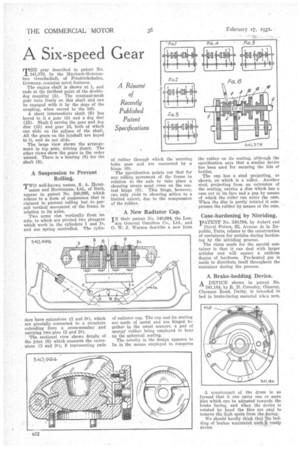A Six-speed Gear
Page 80

If you've noticed an error in this article please click here to report it so we can fix it.
T"gear described in patent No. 341,379, by the Maybach-Motorenban GeselLschaft, of Friedrichshafen, Germany, contains novel features.
The engine shaft is shown at 1, and ends at the farthest point of the doubledog coupling (3). The constant-mesh gear runs freely on this shaft and can be engaged with it by the dogs of the coupling, when moved to the left.
A short intermediate shaft (8) has keyed to it a gear (6) and a dog disc (13). Shaft 5 carries the gear and dog disc (15) and gear 16, both of which can slide on the splines of the shaft. All the gears on the layshaft are keyed to it, and do not slide.
The large view shows the arrangement in top gear, driving direct. The other views show the gears in the order named. There is a bearing (9) for the shaft (8).
A Suspension to Prevent .
Rolling.
TWO well-known names, S. A. Horst
mann and Horstmann' Ltd., of Bath, appear in patent No. 340,996, which relates to a form of suspension that is claimed to prevent rolling but to permit vertical movement of the frame in relation to its axles.
Two arms rise Vertically from an axle, to which are pivoted two plungers which work in the cylinders 1 and la, and are spring controlled. The cylin dare have extensions (3 and 3a), which are pivotally connected to a structure extending from a cross-member and carrying two pins (2 and 2a). The sectional view shows details of the joint (6) which connects the extensions (3 and 8a), 8 representing pads of rubber through which the securing bolts pass and are connected by a hinge (6).
The specification points out that for any rolling movement of the frame in relation to the axle to take place a shearing strain most come on the central hinge (6). This hinge, however, can only yield to shearing action to a limited extent, due to the compression of the rubber.
A New Radiator Cap.
IN their patent No. 340,994, the London General Omnibus Co., Ltd., and 0. W. J. Watson describe a new form of radiator cap. The cap and its seating are made of metal and are hinged together in the usual manner, a pad of spongy rubber being employed to bear on the spherical seating.
The novelty in the design appears to lie in the means employed to compress
the rubber on its seating, although the specification says that a similar device has been used for securing the lids of bottles.
The cap has a stud projecting, as shown, on which is a roller. Another stud, projecting from an extension of the seating, carries a disc which has a cam cut in its face and a gap by means of which the roller can enter the cam. When the disc is partly rotated it cornpresses the rubber by means of the cam.
Case-hardening by Nitriding.
PATENT No. 340,794, by Aubert and Duval Freres, 62, Avenue de la Republic, Paris, relates to the construction of containers for articles during harden
ing by the nitriding process.
The claim made for the special container is that it can deal with larger articles and will ensure a uniform degree of hardness. Pre-heated gas is made to distribute itself throughout the container during the process.
A Brake-bedding Device.
A DEVICE shown in patent No. 341,184, by R. H. Coverley, GlenroY, Clarance Road, Derby, is intended to bed in brake-facing material when new.
A counterpart of the drum is so formed that it can carry one or more files which can be adjusted towards the brake facing, and when the device is rotated by hand the files are said to remove the high spots from the facing.
We should hardly think thatix bedding of brakes warranted such costly device






















































































































